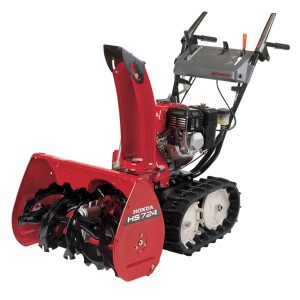 Snowblowers represent a significant investment for most homeowners, and many people are looking for the best ways to maintain and protect that investment over the course of many years. Simply put, the single best way to ensure the Honda HS724 snowblower stands the test of time is to engage in regular maintenance and follow general service guidelines for the equipment as laid out in the operator’s manual. Before getting started with the equipment this winter and every winter, be sure to review a few basic guidelines concerning maintenance, fluids, and more.
Snowblowers represent a significant investment for most homeowners, and many people are looking for the best ways to maintain and protect that investment over the course of many years. Simply put, the single best way to ensure the Honda HS724 snowblower stands the test of time is to engage in regular maintenance and follow general service guidelines for the equipment as laid out in the operator’s manual. Before getting started with the equipment this winter and every winter, be sure to review a few basic guidelines concerning maintenance, fluids, and more.
Don’t Forget to Follow Good Safety Procedures
Performing maintenance requires following safety guidelines perfectly throughout the process. That means keeping the snowblower in an open area, performing maintenance on a flat surface, and declining to work on a snowblower that has been recently used. Hot engines are the leading cause of damage or injury, sparking fuel and burning operators, and they should be avoided when changing the oil, filling the gas tank, or working on other parts of the machinery.
Honda’s Recommended Maintenance Schedule
Honda’s HS724 snowblower comes with an extensive maintenance schedule, which should be carefully reviewed by all new equipment owners before they use the equipment for the first time. Generally, there are a few highlights of this maintenance schedule that merit special attention.
Every Use:
Equipment operators should make sure to check the oil and fuel levels of the snowblower before each use, as well as the integrity and condition of all general bolts, auger bolts, and fasteners on the snowblower. Oil should also be changed after the first 20 hours of use.
Before Operation:
Before putting the equipment into active operation, check the oil, spark plug, and auger shoes. Additionally, be sure to check the chute guide cable, clutch cables, auger belt and drive belt, idle speed, transmission, and drive clearance.
Every 5 Years:
Replace the spark plug at least once every 5 years for easier starting of the equipment and more efficient operation overall.
Refueling and General Fuel Recommendations
The snowblower should be refueled before each use, generally with a cold engine. Never refuel the equipment while the engine is operational or hot from recent use. Also be sure never to refuel the snowblower above the base of the filler neck. When refueling, Honda recommends operators use fuel with an 86 octane rating or higher. Ethanol should be no more than 10 percent of the fuel composition, and methanol should be no more than 5 percent of the fuel’s composition for best results.
Engine Oil Checks and Changes
Oil should be checked before each use and changed after the first 20 hours of use. To check the oil, remove the oil cap and insert the dipstick. Observe the oil level indicated on the dipstick and, if necessary, add extra oil to top off the equipment before using it. Remember to reinsert the dipstick and tightly secure the oil cap before initiating operation, otherwise lubricant will spill out onto the ground and the engine may suffer severe damage if the equipment is operated for an extended period of time.
To change the oil, make sure the equipment is placed on a solid, flat surface and place a drip pan below the oil tank. With the pan in place, remove the oil drain plug and allow all oil to drain successfully before reinserting the plug. Dispose of all drained oil in an eco-friendly way, and be careful not to spill any oil on to the equipment or onto the ground in the process.
Recommended Oil for the HS724
The Honda HS724 snowblower requires 5W30 oil during oil changes or when oil levels are topped off prior to use. Honda has extensive brand recommendations within its owner’s manual, making it easy to purchase the right brand and rating for long-term success.
Hydrostatic Transmission Fluid
The tough thing about checking the snowblower’s transmission fluid levels is that this fluid tends to expand and contract based on the outdoor temperature and the temperature of the equipment itself. For this reason, it’s actually pretty difficult to get an accurate reading of the transmission fluid for the purposes of maintaining a consistent fluid level at all times. Honda aims to fix this problem with a transmission fluid guide, adjusted to coincide with various engine and outdoor temperature levels.
Using this guide along with the dipstick, be sure to check the transmission fluid at regular intervals. If it comes up short, based on temperature and environmental conditions, be sure to add enough fluid to bring it to the “upper” level mark on the dipstick.
For Maintenance, Parts and More, Visit HondaLawnParts.com
The parts lookup tool at HondaLawnParts.com makes it easy for equipment owners to find the OEM replacements they need to keep their snowblower in great shape throughout the winter. Be sure to visit the site right away to find the necessary parts for an easy winter of snow clearing this year and each year in the future.
